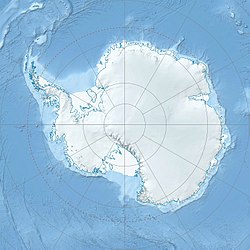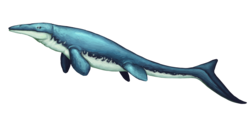Top Qs
Timeline
Chat
Perspective
Lopez de Bertodano Formation
Geologic formation in Antarctica From Wikipedia, the free encyclopedia
Remove ads
The Lopez de Bertodano Formation is a geological formation in the James Ross archipelago of the Antarctic Peninsula. The strata date from the end of the Late Cretaceous (upper-lower Maastrichtian stage[1]) to the Danian stage of the lower Paleocene, from about 70 to 65.5 million years ago, straddling the Cretaceous-Paleogene boundary.[2][3]
Remove ads
Cretaceous-Paleogene boundary

The Cretaceous–Paleogene boundary (K–Pg) crops out on Seymour Island in the upper levels of the Lopez de Bertodano Formation.[4] A small (but significant) iridium anomaly occurs at the boundary on Seymour Island, as at lower latitudes, thought to be fallout from the Chicxulub impactor in the Gulf of Mexico.[5] Directly above the boundary a layer of disarticulated fish fossils occurs, victims of a disturbed ecosystem immediately following the impact event.[4] Multiple reports have described evidence for climatic changes in Antarctica prior to the mass extinction,[6] but the extent to which these affected marine biodiversity is debated. Based on extensive marine fossil collections from Seymour Island, recent work has confirmed that a single and severe mass extinction event occurred at this time in Antarctica just as at lower latitudes.[7]
Remove ads
Climate
Summarize
Perspective
During the Maastrichtian, Seymour Island was located just outside the Antarctic polar circle at around ~64°S latitude.[8] Studies on oxygen-18 isotopes found in belemnites and benthic foraminifera have calculated intermediate-deep-shelf water temperatures at an average of 6 °C (43 °F).[9] This paper also suggested annual temperature variability of 5 °C (41 °F) based on Belemnite growth bands, perhaps in agreement with another study which has suggested that sea surface temperatures may have possibly dropped below freezing and formed sea ice at times.[10] Alternatively, a study using data acquired from ancient bacterial membrane lipids yielded a slightly warmer temperature of 12 ± 5 °C (54 ± 9 °F); further research in other high latitude localities have suggested these methods may be biased towards summer temperatures.[8][11] More recently a paper has used oxygen-18 isotopes from bony fish fossils to estimate an average water temperature of 6.8 °C (44.2 °F), overall supporting a subpolar climate regime perhaps similar to the modern Magallanes Region.[12]

Remove ads
Fossil content
Summarize
Perspective
The Lopez de Bertodano Formation has provided many fossils of flora, dinosaurs and birds.[13][14][15] Also the first fossil egg from Antarctica, Antarcticoolithus, was found in the formation.[16]
Dinosaur remains are among the fossils that have been recovered from the formation[17] and include at least two and probably as much as six lineages of indisputably modern birds: one related to waterfowl, a primitive shorebird or related form, 1 to 2 species of possible loons, a large and possibly flightless bird belonging to a lineage extinct today as well as a partial skull that might belong to either of the smaller species or represent yet another one. The formation also contains a rich fossil invertebrate fauna, including bivalves, gastropods,[18] and cephalopods (ammonites and nautiloids).[19]
The fish assemblage of the López de Bertodano Formation was dominated by Enchodus and ichthyodectiformes, accounting for 21.95% and 45.6% of local fish diversity respectively. Of the remaining percentages, sand sharks made up 10.5%, the cow shark Notidanodon 6.8%, chimaeras 3.9%, saw sharks 2.7%, various other teleost fish 2.4%, and the remaining 6% were shared between other sharks like Paraorthacodus, frilled sharks, Protosqualus, and Cretalamna.[20]
Vertebrates
Dinosaurs
Color key
|
Notes Uncertain or tentative taxa are in small text; |
Ornithischians
Saurischians
Elasmosaurs
Mosasaurs
Fish
Bony fishes
Chondrichthyes
Other fossils
- Ammonites[19]
- Other invertebrates
Remove ads
Flora
Summarize
Perspective
The Maastrichtian represented a period of coolhouse conditions following the gradual global cooling from the Cretaceous Thermal Maximum. Coincident with this trend, an overturning of the Antarctic floral composition occurred during this time, particularly with the diversification of Nothofagaceae and the disappearance of some more archaic angiosperm forms. Other important constituents of the Antarctic floral communities include; Araucariaceae, Podocarpaceae, Atherospermataceae, Myrtaceae, Proteaceae, and Cunoniaceae. Fossil wood and sparse leaves indicates a canopy dominated by Nothofagus, whose wood anatomy suggested a rainforest climate as well as a transition towards deciduousness. Tree rings in Maastrichtian fossil wood are significantly narrower and more distinct than the preceding Coniacian-Campanian periods, indicating less productive growing conditions, and among fossil forests recorded in Antarctica, the Maastrichtian recorded the highest frequency of deferred optimum vessel diameter tree rings which occur when growth commences due to ample moisture availability but temperatures are below the required threshold for peak transpiration. This scenario is common among Nothofagus growing at ca. 55°S today.[57] One study using fossil wood characters calculated mean annual temperatures between 7.3–9.94 °C (45.14–49.89 °F), overall supporting a cool temperate climate for the Maastrichtian Antarctic Peninsula.[58]
Color key
|
Notes Uncertain or tentative taxa are in small text; |
Remove ads
See also
References
Further reading
Wikiwand - on
Seamless Wikipedia browsing. On steroids.
Remove ads






















